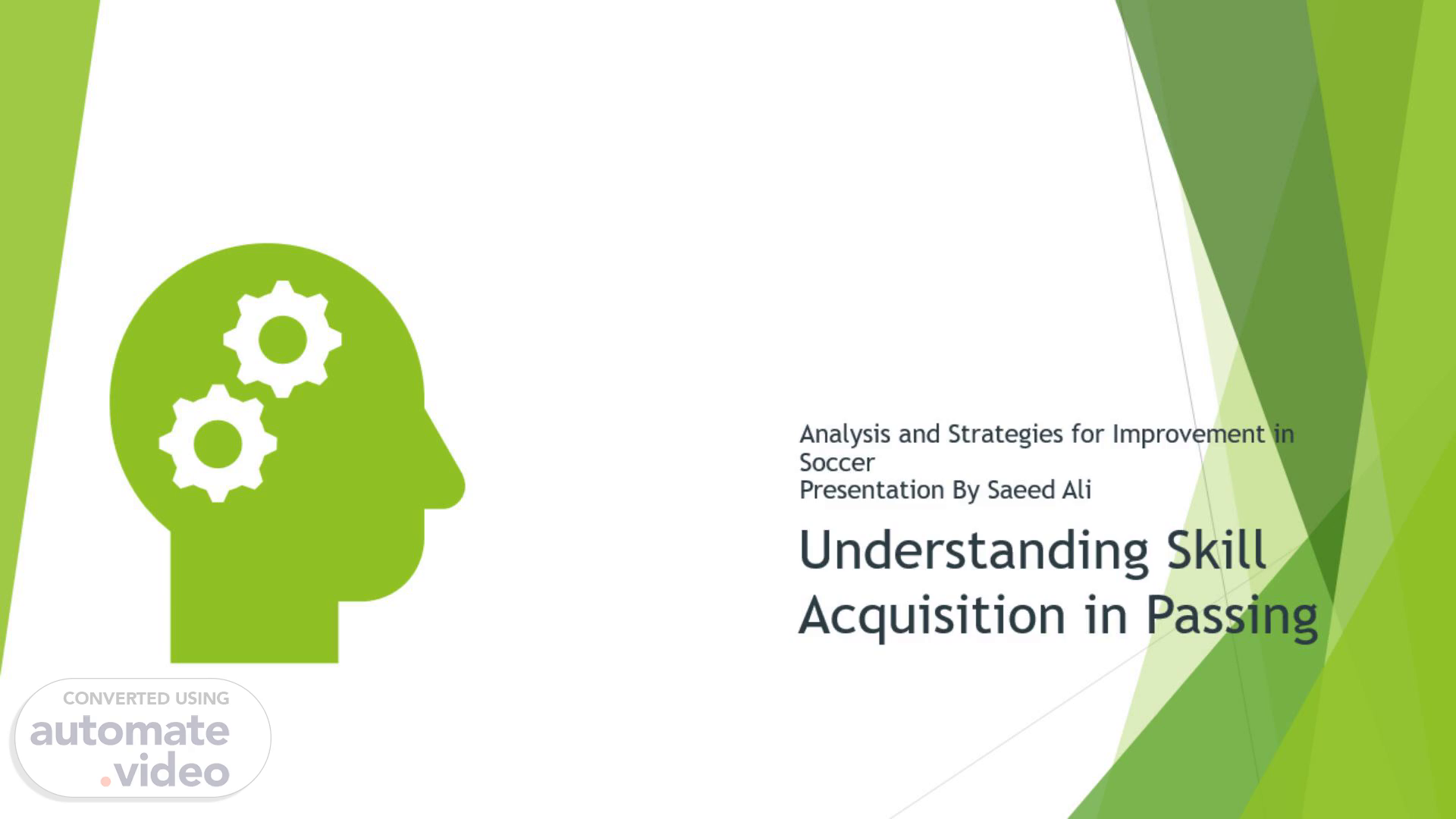Scene 1 (0s)
Understanding Skill Acquisition in Passing. Analysis and Strategies for Improvement in Soccer Presentation By Saeed Ali.
Scene 2 (9s)
[Audio] What constitutes a skill? Definition: A skill is the ability to perform a task with a high degree of proficiency. Classification: Cognitive Skills: Involving mental processes (for example, decision-making). Motor Skills: Physical movements and coordination. Perceptual Skills: Interpreting sensory information to make decisions..
Scene 3 (37s)
[Audio] Types of Skills Open Skills: Performed in changing environments (for example, passing in soccer). Closed Skills: Performed in stable environments (for example, gymnastics routines). Fine Motor Skills: Small movements (for example, threading a needle). Gross Motor Skills: Large movements (for example, running, jumping). Discrete Skills: Clear beginning and end (for example, a tennis serve). Serial Skills: A series of discrete skills (for example, a gymnastics routine). Continuous Skills: No clear beginning and end (for example, swimming)..
Scene 4 (1m 21s)
[Audio] Stages of Skill Development Cognitive Stage: Learning what to do. Understanding the basic mechanics of passing. Associative Stage: Refining technique through practice. Increased consistency and fewer errors. Autonomous Stage: Skill becomes automatic. Ability to execute passes without conscious thought. Examples: Cognitive: Learning the correct foot position and target. Associative: Practicing passing drills with teammates. Autonomous: Executing a perfect pass in a high-pressure game situation..
Scene 5 (2m 1s)
[Audio] Factors Influencing Skill Acquisition. Individual Differences: Age: Younger players may learn faster but require simpler instructions. Motivation: Highly motivated players practice more and improve faster. Physical Attributes: Strength, flexibility, and coordination. Environmental Conditions: Weather: Can affect practice and performance. Facilities: Quality of training grounds and equipment. Task Complexity: Simple tasks are learned faster than complex ones..
Scene 6 (2m 38s)
[Audio] Skill Analysis: Passing in Soccer Description: Passing is transferring the ball to a teammate with precision. Stages of Development: Cognitive: Understanding the proper technique. Associative: Practicing passing with feedback. Autonomous: Passing accurately under game pressure. Video Example: (submitted with the power point).
Scene 7 (3m 5s)
[Audio] Types of Passing in Soccer: Short Passes: Upright stance, quick wrist movements. Long Balls: Leaning back slightly, using the whole arm for power. Through Passes: Angled body towards the target, precise foot placement. One-Touch Pass: When the ball is played to you, you only have one touch to pass it on fast and efficiently..
Scene 8 (3m 31s)
[Audio] Case Studies in Skill Acquisition Example 1: Young Player Learning to Pass Age: 10 years old Motivation: High, enjoys the game Environment: Regular coaching sessions Outcome: Steady improvement over a season Example 2: Professional Player's Development Age: 25 years old Motivation: High, professional goals Environment: Advanced training facilities Outcome: Mastery of complex passing techniques Example 3: Toni Kroos Player: Toni Kroos, midfielder for Real Madrid Performance: 95% pass completion rate with 92% accuracy Factors: High skill level, excellent training facilities, strong motivation Comparison: Young players benefit from simple, engaging drills. Professional players, like Toni Kroos, benefit from tailored, high-intensity training and extensive experience..
Scene 9 (4m 36s)
[Audio] Impact of Factors on Passing in Soccer: Age: Young players need simplified drills; older players can handle more complex scenarios. Motivation: Players who enjoy soccer and have clear goals improve faster. Practice Methods: Consistent, focused practice with feedback enhances skill acquisition. Physical Attributes: Speed, agility, and balance affect passing ability..
Scene 10 (5m 3s)
[Audio] Strategies for Enhancing Passing Skills: Practice Methods: Drills: Repetitive passing drills to build muscle memory. Small-Sided Games: Encourage frequent passing under pressure. Feedback Mechanisms: Video Analysis: Reviewing performance to identify areas for improvement. Coaching Tips: Immediate feedback during practice sessions. Mental Strategies: Visualization: Imagining successful passes before executing them. Goal Setting: Setting specific, measurable goals for improvement..
Scene 11 (5m 43s)
[Audio] Justification of Strategies. Practice Methods: Repetition and small-sided games enhance muscle memory and decision-making. Feedback Mechanisms: Video analysis and coaching tips provide concrete, actionable insights. Mental Strategies: Visualization and goal setting boost confidence and focus, leading to better performance..
Scene 12 (6m 9s)
[Audio] Conclusion. Summary: Understanding and improving skill acquisition in passing involves multiple factors and strategies. Importance: Mastering passing is crucial for success in Football (soccer). Application: These insights can be applied to other sports and physical activities..
Scene 13 (6m 30s)
[Audio] References.. References. Passing Techniques In Football - Top Soccer Coach. [online] Top Soccer Coach. Available at: https://topsoccercoach.com/passing-techniques-in-football/ [Accessed 7 Aug. 2024]. Jacplus on stages of skill development - https://www.jacplus.com.au/ Mukhopadhyay, A. (2022). The Top 10 best passers in the world as of 2022. [online] Sportzpoint. Available at: https://sportzpoint.com/football/the-top-10-best-passers-in-the-world-as-of-2022..
